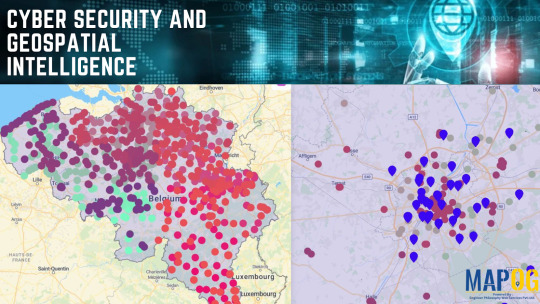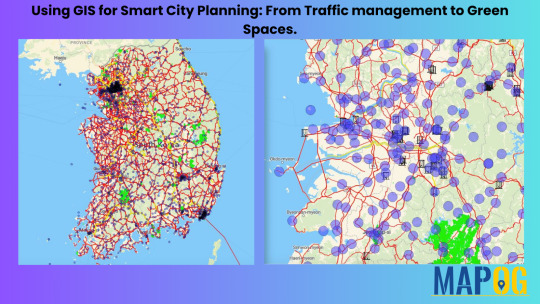#gistool
Explore tagged Tumblr posts
Text
How to Use GIS for Wildlife Monitoring and Prevention
Wildlife monitoring and conservation are essential for protecting our planet’s biodiversity. By providing detailed habitat mapping, data analysis, and predictive modeling, GIS helps track animal movements, monitor habitat changes, and forecast the impact of threats like climate change and human encroachment. It aids informed decision-making, ensures efficient resource allocation, and enhances the enforcement of laws by identifying illegal activities.

Using GIS for Wildlife Monitoring and Prevention with MAPOG
Wildlife monitoring and conservation are essential for protecting our planet’s biodiversity. We can monitor wildlife by leveraging platforms like MAPOG is a user-friendly GIS platform that helps conservationists and researchers track wildlife habitats, monitor land use, and protect endangered species.
MAPOG simplifies wildlife monitoring for better conservation efforts.
Technology now makes wildlife monitoring accessible to all conservation teams. By combining satellite views with GIS data, users can quickly spot protected areas and human-wildlife conflict zones through color-coded maps. All through a clear, visual system that anyone can understand.
Additionally, GIS facilitates collaboration by allowing stakeholders to share data and work together on conservation projects. It also visualizes human impact on wildlife, helping to raise public awareness and generate support for wildlife protection.
Conclusion
MAPOG simplifies the GIS process for wildlife conservation, offering tools that make it easier to visualize, share, and analyze vital data. Whether you're monitoring animal populations, investigating land use changes, or understanding the impact of human activities, MAPOG's user-friendly interface provides the insights you need.
By using MAPOG, conservationists, researchers, and policymakers can work together to safeguard wildlife and habitats for future generations. Start utilizing MAPOG today to contribute to protecting the world’s wildlife.
0 notes
Text
The role of GIS in Cyber Security and Geospatial Intelligence
In today’s digital age, where cyber threats are becoming more sophisticated and widespread, the need for innovative tools to combat these risks has never been greater. Enter Geographic Information Systems, a technology that has traditionally been used for mapping and spatial analysis but is now playing a pivotal role in cybersecurity and geospatial intelligence.
This blog explores how GIS is revolutionizing industries by providing actionable insights and enhancing strategic planning.

By combining the power of GIS with cybersecurity, organizations can visualize, analyze, and respond to threats in ways that were previously unimaginable. Here is step by step to enhance by using cloud based like MAPOG:
Step 1: Create a New Map
Launch Your Project: Begin by clicking the “Create New Map” button to open a fresh workspace.

Select a Base Map: Choose from a variety of base map options, such as satellite imagery, terrain views, or street maps, to establish a clear and detailed foundation for your project.

Import Data:

Step 2: Style and Analyze Your Data
. Customize Your Map:
Navigate to the “Action” button and choose “Style Layer.”
Utilize the “Heat style” feature to visualize areas with varying levels of activity, such as cybersecurity attack hotspots or regions with high user engagement.
Modify colors, labels, and icons to enhance the map’s visual appeal and clarity.

Conduct Advanced Analysis:
Access the "process data" select "Near By Neighbor" and specify the main layer, attributes, and joining layer.
Set parameters such as a 3000-meter radius and a limit of 10 results, then proceed to submit.
Refine the layer’s appearance by revisiting the “Action” button and selecting “Style Layer” for improved visualization.

The “Heat Style” feature can be employed to spotlight regions experiencing frequent cyberattacks. This visual approach simplifies resource allocation and the implementation of preventive strategies.
Step 3: Share and Collaborate
Distribute Your Map:
Share your map with others by generating a public or private link through the “Preview & Share” option.
Embed the map on websites or blogs to broaden its accessibility.
Engage with Teams:

Industries and Domains
GIS is revolutionizing multiple sectors by delivering spatial insights and improving decision-making processes. Key applications include:
Cybersecurity: Map the geographic sources of cyberattacks and safeguard military networks.
Fraud Detection: Analyze and map geographic trends in cyber fraud, such as ATM skimming.
GIS Data Used in This Example
Boundary Data: To outline the geographic scope of the map.
Police Stations: To locate law enforcement facilities.
ATMs: To assess potential hotspots for cyber fraud.
Conclusion
By harnessing the power of GIS, organizations can strengthen their cybersecurity defenses, enhance situational awareness, and make informed, data-driven decisions. Whether you’re a cybersecurity specialist, a geospatial analyst, or a researcher, MAPOG can transform your projects by delivering actionable insights through geospatial intelligence.
MAPOG is a dynamic platform that enables users to craft professional, insightful maps effortlessly. Its intuitive interface, robust analytical tools, and secure features make it an essential resource for professionals across various fields.
0 notes
Text
Using GIS for smart city planning: From Traffic management to Green Spaces
Introduction
In the era of modern urbanization, cities are grappling with challenges such as traffic congestion, environmental pollution and smart city planners have emerged a solution by leveraging GIS technology which has become an indispensable tool in this transformation by enabling city planners to visualize, analyze and optimize urban systems. GIS has revolutionized how cities are planned and managed.
Traffic Management: Tacking Congestion with GIS

Step1: Upload GIS Data
Go to the GIS Data and select your area of interest by searching in the search box and apply.
Now from the “other layer” select what layers you need (for exampleTransport: Road, Parks, buildings etc.) and click on the “Add on Map” button to appear on the screen.
To customize the layer click on the “Action” button and select “edit layers” and change the colors, icons, radius and opacity according to your Legends.
Step2: Add Buffer Tool
Go to the Processing Data button and select Buffer Tool now select the layers and set the radius to 2000 meters and Convert.
Step3: Share and Publish
Finally, we can share and publish our map in public or private with stakeholders. MapOG’s collaboration features allow you to gather feedback and make real-time updates, ensuring everyone is on the same page.
Conclusion
Green spaces are essential for improving air quality, reducing urban heat, and enhancing the well-being of residents. GIS plays a crucial role in identifying suitable locations for parks, urban forests, and community gardens. By analyzing factors such as population density, land use, and environmental conditions, tools like MAPOG help planners allocate green spaces effectively. GIS also supports community engagement, allowing citizens to participate in the planning process and ensuring that green spaces meet local needs.
0 notes